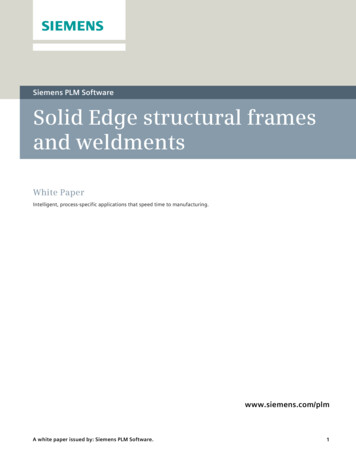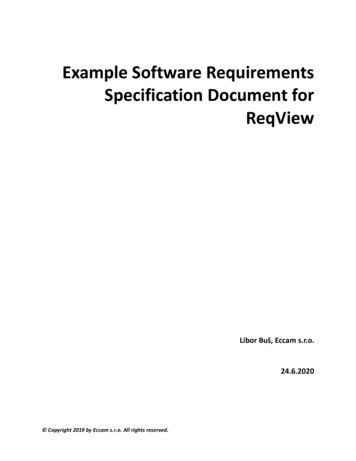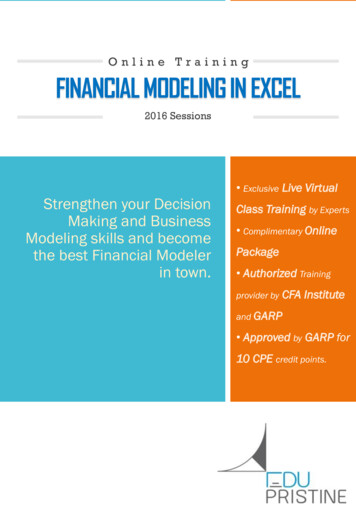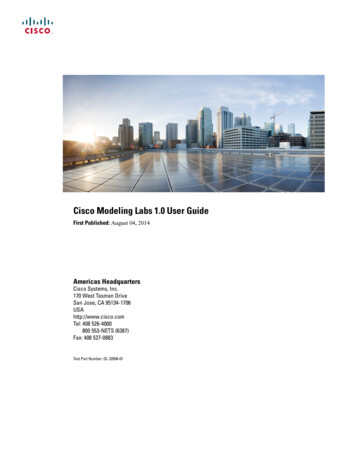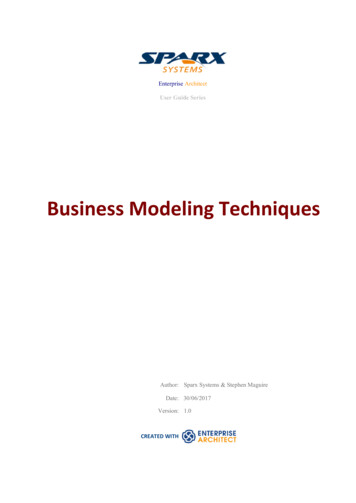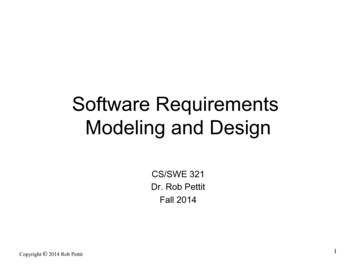
Transcription
Software RequirementsModeling and DesignCS/SWE 321Dr. Rob PettitFall 2014Copyright 2014 Rob Pettit1
Course Logistics Web: http://cs.gmu.edu/ rpettit/swe321.html– Syllabus, schedule, and project information– Lecture notes updated weeklyBlackboard– AssignmentsPiazza (https://piazza.com/gmu/fall2014/swe321/home)– Discussion board and announcementsOffice Hours: 8:00-9:00am Tu/Th in Engineering 4437 (Email toconfirm)– Email Anytime: rpettit@gmu.eduRecommended Text:– Gomaa - “Software Modeling and Design”Recommended Software:– StarUML or Papyrus UML (via Eclipse)Prerequisites:– CS 211Copyright 2014 Rob Pettit2
Grading Project assignments (40%)Project Report (10%)Mid-term Exam (25%)Final exam (25%)Copyright 2014 Rob Pettit Grading Scale:–––––––––––98 :A 92-97.9 : A90-91.9: A88-89.9: B 82-87.9 : B80-81.9: B78-79.9: C 72-77.9: C70-71.9: C60-69.9: D 60 : F3
About Me Dr. Rob Pettit: email: rpettit@gmu.edu– B.S. Computer Science / Mathematics, University of Evansville– M.S. Software Systems Engineering, GMU– Ph.D. Information Technology / Software Engineering (SoftwareDesign and Architectural Analysis), GMU– The Aerospace Corporation Lead Flight Software and Embedded Systems Office Oversight of large real-time, object-oriented software analysisand design efforts for mission-critical systems– Teaching GMU: SWE 621, SWE 626, SWE 632, CS/SWE 321 VT: CS5744, CS5704– Research Interests Real-time object-oriented design Software performance analysisCopyright 2014 Rob Pettit4
So, what’s this course really about? From the GMU catalog:In a nutshell:– Introductory course to software engineeringCopyright 2014 Rob Pettit5
What is Software? More than just programs and code– Computer instructions– Data structures– Documentation– ModelsProgram– Typically 50 -500 lines of code– Developed by one personSoftware system– Much larger, typically consisting of many programs workingtogether– Needs a team of software engineers– Need project management and organization– Need a software life cycle Phased approach to software developmentCopyright 2014 Rob Pettit6
What is Software? Software is developed or engineered– Not manufactured in the classical senseSoftware doesn’t “wear out”Software is typically not mass produced– Lots of custom-built software At least at the feature levelCopyright 2014 Rob Pettit7
Wear vs. Deteriorationincreased failurerate due to side effectsFailureratechangeactual curveidealized curveTimeCopyright 2014 Rob Pettit8
What is Engineering? Engineering is – The application of scientific principles andmethods to the construction of useful structures &machines Examples––––––Mechanical engineeringCivil engineeringChemical engineeringElectrical engineeringNuclear engineeringAeronautical engineeringCopyright 2014 Rob Pettit9
What is Software Engineering? Engineering– Applied Science Electrical engineering– Applied Physics Software Engineering– Applied Computer scienceCopyright 2014 Rob Pettit10
What is Software Engineering? The term is 40 years old– NATO Conference on “Software Crisis”– Garmisch, Germany, October 7-11, 1968 Software Crisis––––Software development projects were delivered lateSoftware was full of errorsSoftware did not satisfy requirementsSoftware was difficult to maintainCopyright 2014 Rob Pettit11
What is Software Engineering? IEEE (Institute of Electrical and Electronics Engineers) definition– “The application of a systematic, disciplined, quantifiableapproach to the development, operation and maintenance ofsoftware, that is, the application of engineering to software”. OR – Software engineering is the establishment and use of soundengineering principles in order to obtain economicallydeveloped software that is reliable and works efficiently onreal machinesCopyright 2014 Rob Pettit12
Why Are There Difficulties? Software Engineering is a unique brand ofengineering–––––Software is easy to changeSoftware construction is human-intensiveSoftware is intangibleSoftware problems are very complexSoftware directly depends upon the hardware It is at the top of the system engineering “food chain”– Copyright 2014 Rob Pettit13
Software Processes Also known as Software Life Cycles– Phased approach to software development– Provide guidance on what must be created when And (importantly) guidance on how to create andevaluate artifactsGenerically consist of framework and umbrella activitiesCopyright 2014 Rob Pettit14
Framework Activities" Specific phases of the software development life cycle can bedescribed in terms of:"" – Communication"– Planning"– Modeling" Analysis of requirements" Design"– Construction" Code generation" Testing"– Deployment""Almost any software development process / life cycle can bedescribed in terms of these framework activities."Copyright 2014 Rob Pettit15"
Umbrella Activities" Umbrella activities are performed throughout the life cyclephases.""– Software project management"– Formal technical reviews"– Software quality assurance"– Software configuration management"– Work product preparation and production"– Reusability management"– Measurement"– Risk management"" Umbrella activities focus on quality and management aspects"Copyright 2014 Rob Pettit16"
Process Flow" Life cycle activitiesmust be paired witha flow model– Identified whenactivities occurCopyright 2014 Rob Pettit17"
Adapting a Process Model" Each software development effort must define the process to be used! Often start with an “off the shelf” process and then tailor it to meet specificproject needs! Final, specific version to be applied is defined in the Software DevelopmentPlan (SDP)! Factors for choosing and tailoring a process model include:!– the criticality and nature of the system to be developed!– the overall flow of activities, actions, and tasks !– the degree to which work products are identified and required!– the manner in which quality assurance activities are applied!– the manner in which project tracking and control activities are applied!– the overall degree of detail and rigor with which the process is described!– the degree to which the customer and other stakeholders are involvedwith the project!– the level of autonomy given to the software team!– the degree to which team organization and roles are prescribed!Copyright 2014 Rob Pettit18"
Prescriptive vs. Agile Process Models" Prescriptive process models advocate an orderly approach tosoftware engineering"– Waterfall"– Incremental"– Evolutionary / Spiral"– Unified Process"– COMET (Gomaa book)"Agile process models advocate flexibility and speed"– XP (Extreme Programming)"– Scrum"Both types of process models have their place in softwareengineering"""Copyright 2014 Rob Pettit19"
The Waterfall Model"Communicationprojec t init iat ionrequirement gatheringPlann in gestimatin gsc hed uli ngtra ck ingModelinganalysisdesign20"Copyright 2014 Rob PettitConstr uc tioncodetestDeploymentdeliverys upportf eedba c k
The Incremental Model"increment # nCommunic at ionPlanningM odelinga na lys isdes ignCo n s t ru c t i o nc odet es tDe pl o y m e n td e l i v e ryfe e d b a c kdelivery ofn th incrementincrement # 2Com munic a t i onPlanningM odelinganalys isdes ignC o n s t ru c t i o ncodeDe p l o y m e n tt es td e l i v e ryfe e d b a c kincrement # 1Communicat ionPlanningM odelingana lys isdes ignC o n s t ru c t i o ncodeDe p l o y m e n tt es td e l i v e ryfe e d b a c kdelivery of1st incrementproject calendar time21"Copyright 2014 Rob Pettitdelivery of2nd increment
Evolutionary Models: The Spiral"planningestimationschedulingrisk ploymentconstructiondeliveryfeedbac kcodetest22"Copyright 2014 Rob Pettit
The Unified Process structionReleasetransitionsoftware incrementproduction23"Copyright 2014 Rob Pettit
Collaborative Object Modeling and architectural design mEThod(COMET)Communication / PlanningFigure 5.1: COMET use case based software life cycle modelModeling - AnalysisUserRequirementsModelingModeling - ncrementalPrototypingCustomerCopyright 2014 Rob PettitDeployment24
Agile Software Development" Drivers:"– Faster delivery of working software to customers without“excessive” process burdens"– Avoidance of things that “waste time”"Agile methods emphasize:" Individuals and interactions over processes and tools ! Working software over comprehensive documentation ! Customer collaboration over contract negotiation ! Responding to change over following a plan !Copyright 2014 Rob Pettit25"
Extreme Programming (XP)" The most widely used agile process, originally proposed by KentBeck"XP Planning"– Begins with the creation of “user stories”"– Agile team assesses each story and assigns a cost"– Stories are grouped together for a deliverable increment"– A commitment is made on delivery date"– After the first increment “project velocity” is used to helpdefine subsequent delivery dates for other increments"Copyright 2014 Rob Pettit26"
Extreme Programming (XP)"user storiesvaluesacceptance test criteriaiteration plansimple designCRC cardsspike sesoftware incrementproject velocity computedunit testcontinuous integrationacceptance testingCopyright 2014 Rob Pettit27"
Scrum" Originally proposed by Schwaber and Beedle" Scrum—distinguishing features"– Development work is partitioned into “packets”"– Testing and documentation are on-going as the product isconstructed"– Work occurs in “sprints” and is derived from a “backlog” ofexisting requirements"– Meetings are very short and sometimes conducted withoutchairs"– “demos” are delivered to the customer with the time-boxallocated"Copyright 2014 Rob Pettit28"
Scrum"Copyright 2014 Rob Pettit29"
Agile vs. Prescriptive Processes"Agile"1. Small products andteams; scalabilitylimited"2. Untested on safetycritical products"3. Good for dynamic, butexpensive for stableenvironments."4. Require experiencedAgile personnelthroughout"5. Personnel thrive onfreedom and chaos"Copyright 2014 Rob PettitPrescriptive"1. Large products andteams; hard to scaledown"2. Handles highly criticalproducts; hard to scaledown"3. Good for stable, butexpensive for dynamicenvironments"4. Require experiencedpersonnel only at startif stable environment"5. Personnel thrive onstructure and order"
ReviewSoftware Engineering in a Nutshell Development of software systems whose size/complexity warrants team(s) of engineers– Multi-person construction of multi-version software Scope– Software process (life cycle)– Software development principles– Software methods and notations Goals– Production of quality software,– Delivered on time, within budget,– Satisfying customers’ requirements and users’ needsCopyright 2014 Rob Pettit31
SOFTWARE MODELINGCopyright 2014 Rob Pettit32
Software Modeling and Design Origins of Modeling– Vitruvius, De Architectura, 1st century B.C.– Architectural modelsModeling in science and engineering– Build model of system at some level of precision and detail– Analyze model to get better understanding of systemSoftware Modeling– Modeling is designing of software applications before codingCopyright 2014 Rob Pettit33
The Need for Models A model is – an abstraction that allows us to represent varying layers ofcomplex informationModels help us – Organize– CommunicateTools we need to develop andmaintain complex software systems– Reason– AnalyzeTradeoffs– Larger effort– Delayed return Where’s my SLOC?– Additional skills requiredCopyright 2014 Rob Pettit34
Why Do We Bother? Programming in the small is no longer feasible for most applicationsSoftware size is increasing exponentially– Example from space missions: 1970’s: 3 KSLOC 1980’s: 8 K 1990’s: 32 K Current satellite system: multi-millions– Abstraction is essential to contain the complexityMost problems with software systems occur when different pieces haveto interact– Still a poorly understood problem– Problems often discovered late and with great cost– Often leads to performance issues tooHalf of all modern space system anomolies can be traced tosoftware!Copyright 2014 Rob Pettit35
Modeling and Analysis for Risk Mitigation Early modeling and analysis can reduce incidental complexity– FSW has inherent essentially complexity by nature– Incidental complexity arises from choices we make duringrequirements, architecture, design, and codingModel-based methods can– Ensure consistency from requirements è architecture è design è code– Detect deviations from development standards– Assist trade studies in hardware/software architectures– Point to problems with performance and reliability in theearly stages– Locate potential issues such as deadlocks and raceconditions while they can still be repairedCopyright 2014 Rob Pettit36
Flight Software Impact on Mission SuccessFSW SLOC Count1SW-Related ar40000UHF F/O200000DSPPhase 119651975DSP1985199520051965197519851995FSW SLOC Flight Software Source Lines of Codes Software is growing in size and complexityRecent trends have seen significant grown in mission criticalfailuresApproximately half of all modern space systems anomolies arerelated to software21Cheng,Paul, “Ground Software Errors Can Cause Satellites to Fail Too”, GSAW 2003Myron,and Douglas Buettner, “Software Testing in Space Programs”, Crosslink, 6(3), Fall 2005Copyright 2014 Rob Pettit2Hecht,2005
Model-Driven Software Engineering MDE, MDD, MDA, MDSE, Software engineering has a long history of raising levels ofabstraction– Binaryð Assembly ð 3GL ð OO Code ð UML ð Patterns ð Models become primary artifacts of software development– May or may not include code generation– Much more rigorous models than previously used in softwaredesignCopyright 2014 Rob Pettit38
Unified Modeling Language (UML) UML is the standard modeling language for object-orientedsoftware designs– Version 1.4 – large legacy base supported by many tools– Version 2.0 – recently adopted update, most modern toolreleases now support this– Version 2.4.1 – absolute latest - limited tool supportTypes of Models Inclucde – Use Case Models Capture black-box functional requirements– Activity Models Model detailed interactions within use case– Static Models Capture structural elements– Dynamic Models Capture behavioral elementsCopyright 2014 Rob Pettit39
Different modeling views help to understand different aspects of the system AND allow us to useabstraction to focus on one piece of the puzzle at a timeCopyright 2014 Rob Pettit40
Overview of Software Modelingand Design Method Collaborative Object Modeling and architectural design mEThod(COMET)– Object Oriented Analysis and Design Method– Uses UML (Unified Modeling Language) notation Standard approach for describing a software design– COMET UML MethodCopyright 2014 Rob Pettit41
Overview of Software Modelingand Design Method Collaborative Object Modeling and architectural design mEThod(COMET)– Object Oriented Analysis and Design Method– Uses UML (Unified Modeling Language) notation Standard approach for describing a software design– COMET UML MethodProvides steps and guidelines for– Software Modeling and Design– From Use Case Models to Software ArchitectureCourse text: H. Gomaa, Software Modeling and Design:UML, Use Cases, Patterns, and Software Architectures,Cambridge University Press, 2011Copyright 2014 Rob Pettit42
Figure 5.1 COMET use case based software life cycle modelFigure 5.1: COMET use case based software life cycle lPrototypingSystemTestingCustomerCopyright 2014 Rob Pettit43
Requirements Modeling Use Case Modeling– Define software functional requirements in terms of use casesand actorsUse CaseActorUse Case AFigure 2.1 UML notationfor use case diagram«extend»«extend»Use Case BUse Case CUse Case X«include»Use Case YCopyright 2014 Rob Pettit«include»Use Case Z44
Analysis Modeling Analysis Modeling consists of Static Modeling View of system that does not change with time Dynamic Modeling View of system that does change with timeFigure 5.1: COMET use case based software life cycle lPrototypingSystemTestingCustomerCopyright 2014 Rob Pettit45
Analysis Modeling Static Modeling– Define structural relationships between classes– Depict classes and their relationships on class 1ClassBClassCAssociationAssociation(with direction in whichassociation name is read)(with direction pecializationFigure 2.3 UML notation for classesCopyright 2014 Rob Pettit46
Analysis Modeling Dynamic Modeling– Defines sequence of objects communicating with each other usingcommunication diagrams or sequence diagramsFigure 2.6: UML notation for sequence equestMessage5:ReplyCopyright 2014 Rob Pettit47
Design Modeling Develop overall softwarearchitecture– Structure system intosubsystems– Design object-oriented ice»ReceiptPrinterFigure 5.1: COMET use case based software life cycle spenser1Copyright 2014 Rob Pettit«externaluser»ATMCustomer48
COMET Software Life Cycle Incremental SoftwareConstruction– Select subset of system basedon use cases– For each class in subset Detailed design inPseudocode– Structured English Coding– E.g., Java Unit test– Test individual objects– (instantiated fromclasses)Copyright 2014 Rob PettitFigure 5.1: COMET use case based software life cycle lPrototypingSystemTestingCustomer49
COMET Software Life Cycle Incremental SoftwareConstruction Incremental SoftwareIntegration– Integration testing of eachsystem increment– Integration test based onuse casesUserFigure 5.1: COMET use case based software life cycle totypingSystemTestingCustomerCopyright 2014 Rob Pettit50
COMET Software Life Cycle Incremental SoftwareConstruction Incremental Software Integration System Testing– Testing of softwarefunctional requirements– Based on use casesUserFigure 5.1: COMET use case based software life cycle totypingSystemTestingCustomerCopyright 2014 Rob Pettit51
For Next Week Complete individual bio sketch (see Blackboard assignment)Form teams of 4-5 students per team– Complete team formation report– Team leader – email report to me before class nextTuesday.Copyright 2014 Rob Pettit52
Backup materialADDITIONAL DEFINITIONSCopyright 2014 Rob Pettit53
Software Engineering Software Programming Software programming––––Single developerSmall applicationsShort lifespanSingle or few stakeholders Architect Developer Manager Tester Customer User– One-of-a-kind systems– Built from scratch– Minimal maintenanceCopyright 2014 Rob Pettit54
Software Engineering Software Programming Software engineering––––Teams of developers with multiple rolesComplex systemsIndefinite lifespanNumerous stakeholders Architect Developer Manager Tester Customer User– System families– Reuse to amortize costs– Maintenance can account for over 60% of overalldevelopment costsCopyright 2014 Rob Pettit55
Definitions Systematic– Characterized by the use of order and planningDisciplined– Controlled, managed, kept within certain boundsQuantifiable– MeasureableCopyright 2014 Rob Pettit56
Definitions Software development– The production of software– From analyzing user requirements to testing of softwareCopyright 2014 Rob Pettit57
Definitions Software development– The production of software– From analyzing user requirements to testing of softwareOperation– Environment in which software runs: Hardware platform (e.g., PC, Mac) Operating system (e.g., Windows, Linux) Networks– Software deployment Installation of working softwareCopyright 2014 Rob Pettit58
Definitions Software development– The production of software– From analyzing user requirements to testing of softwareOperation– Environment in which software runs: Hardware platform (e.g., PC, Mac) Operating system (e.g., Windows, Linux) Networks– Software deployment Installation of working softwareMaintenance– Modification of software after installationCopyright 2014 Rob Pettit59
software, that is, the application of engineering to software”. OR – Software engineering is the establishment and use of sound engineering principles in order to obtain economically developed software t




